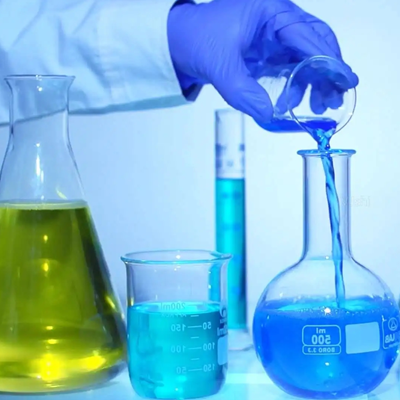Scale Inhibition Mechanism of Tetrakis Hydroxymethyl Phosphonium Sulfate(THPS)
Tetrakis Hydroxymethyl Phosphonium Sulfate(THPS) has important applications in oilfield development. It can be used in combination with other bactericides and scale inhibitors, and can be used alternately with glutaraldehyde. THPS has a low bactericidal concentration and exhibits good stability at different temperatures and pH values. Dissolution methods for removing FeS are simple, effective, and inexpensive, making them a commonly used method. Common FeS removal methods include acid washing, alkaline washing, high-pH solvent washing, and multi-stage oxidant cleaning, but these methods all have shortcomings. Acid washing is costly, has a high corrosion rate, and easily causes secondary pollution; alkaline washing is difficult to treat wastewater and has poor removal efficiency for ferrous sulfide; high-pH solvent washing is costly and requires two wastewater treatments; multi-stage oxidant cleaning is unsafe to operate, has side reactions, and the wastewater contains heavy metal ions such as manganese and chromium.
Active sulfur corrosion and spontaneous combustion of corrosion products in oil storage tanks have always been major problems faced by oil refining enterprises both domestically and internationally. Fires and explosions caused by spontaneous combustion of active sulfur corrosion products occur frequently. These accidents were mainly caused by the spontaneous combustion of ferrous sulfide produced by sulfur corrosion in oil storage tanks. Using highly efficient reagents to dissolve and remove ferrous sulfide is a more effective way to solve fires and explosions caused by the spontaneous combustion of active sulfur corrosion products. To improve removal efficiency, reduce costs, and minimize secondary pollution, the method of dissolving and removing ferrous sulfide using complexing agents has been widely applied. This complexing agent can react rapidly with ferrous sulfide to form a water-soluble complex, which will not corrode equipment and leaves no harmful residues. Tetrakis Hydroxymethyl Phosphonium Sulfate(THPS) is an economical and environmentally friendly complexing agent that can effectively dissolve FeS to form a water-soluble complex and has good biodegradability and environmental safety.
1. Experimental Methods
1.1 Preparation of the Solution
In a 10mL beaker, first add a certain mass of Tetrakis Hydroxymethyl Phosphonium Sulfate(THPS), dilute with 10mL of water, then add a certain mass of ammonium chloride, stir to dissolve, and dilute with water until the total mass of the solution reaches 50g. Finally, adjust the pH of the solution with NaOH.
1.2 Dissolving Ferrous Sulfide
Adjust the stirring speed to 72 r/min, maintain the temperature at 40℃, add 1g of ferrous sulfide to the solution, observe the changes in the solution, stop stirring after 4 hours, allow to stand and filter, and determine the mass concentrations of iron ions and sulfur ions in the filtrate. After drying the filter residue at 60℃, weigh it and calculate the solubility rate of ferrous sulfide. Based on the cleaning effect of the solution on ferrous sulfide, determine the optimal ratio of each component in the solution.
2. Test Principle
Tetrakis Hydroxymethyl Phosphonium Sulfate(THPS) is a colorless, transparent crystalline compound with strong hygroscopicity. It is readily soluble in water and lower alcohols, but insoluble in other organic solvents. The central phosphorus atom of THPS is connected to four hydroxymethyl groups through sp³ hybrid orbitals, forming a tetrahedral structure. The phosphorus atom carries a positive charge, and the molecular structure is very stable. The central phosphorus atom of THPS carries a positive charge, and the strong polarity of the phosphorus-carbon bond causes the carbon atom adjacent to the phosphorus atom to carry a negative charge (forming a carbanion). Carbanions are strong nucleophiles and can react with many compounds containing active hydrogen atoms, such as N-hydroxymethyl compounds, phenols, polybasic acids, and amines. THPS can dissolve FeS because it can form a water-soluble complex with the ferrous ions in FeS. Studies have found that in the presence of ammonium ions, THPS and FeS more readily form a metal complex under system conditions, leveraging the potent effect of ions. This metal complex reacts faster and is more water-soluble than simple Tetrakis Hydroxymethyl Phosphonium Sulfate(THPS).
3. Test Results Under optimal conditions (pH=5, reaction temperature 80℃, reaction time 8h), this solution showed the best removal effect on ferrous sulfide; increasing the mass fraction of the solution helped to better dissolve ferrous sulfide. When pH=5, reaction temperature 80℃, and reaction time 8h, the dissolution rate of ferrous sulfide was 56% with a solution mass fraction of 6%; when the solution mass fraction increased to 14%, the dissolution rate reached 73%. Therefore, the solubility of ferrous sulfide increases with the increase of the mass fraction of the solution.
In summary, Tetrakis Hydroxymethyl Phosphonium Sulfate(THPS), under the synergistic effect of radical ions, can form a water-soluble complex with ferrous ions in FeS, thereby effectively dissolving ferrous sulfide in oil tanks and preventing the hazards caused by spontaneous combustion of ferrous sulfide. The mass fraction of THPS has a significant impact on the dissolution effect of ferrous sulfide, while pH, reaction temperature, and reaction time have little effect on the dissolution effect of phosphate/THPS. In practical applications, appropriately increasing the mass fraction of THPS can enhance its dissolution effect on ferrous sulfide. Of course, if THPS can be used in combination with other water treatment agents and bactericides, its effect on inhibiting petroleum scaling and sterilization may be more significant and efficient, and further research and development are needed in specific areas.
 Scale Inhibition Mechanism of
Scale Inhibition Mechanism of
 Mechanism of Action and Perfor
Mechanism of Action and Perfor
 MPP Flame Retardant|CAS 218768
MPP Flame Retardant|CAS 218768
 Does sodium hypophosphite cont
Does sodium hypophosphite cont


